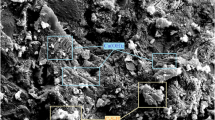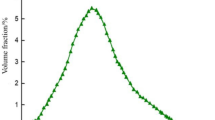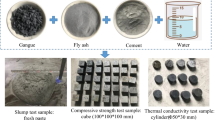Abstract
In geothermal reservoir exploitation, the thermal conductivity of casing cement material is a key parameter that may affect the heat exchange and utilization efficiency of geothermal reservoirs. Based on a systematic approach of theoretical analysis, experimental research and microscopic analysis, this paper presents graphite composite cement (GC) with high thermal conductivity for potential application in geothermal reservoir exploitation. The GC consists of ordinary Portland cement (P.O 42.5), natural flake graphite, water-reducing agent (GB), early strength agent (CaCl2) and defoamer (HB-03). The physical properties of the GC, such as fluidity, pumpability, setting time, compressive strength and thermal conductivity, were obtained by carefully prepared laboratory tests that met our expectation. Finally, X-ray diffractometry and environmental scanning electron microscopy were used to analyze the micro-characteristics for an interpreted thermal conduction mechanism of GC. The results of analyses show that the formation of thermal conductivity network of natural flake graphite in cement is a key to improve thermal conductivity. The research results provide a new solution to the problems of low thermal energy extraction efficiency and poor cementing quality of geothermal reservoirs.








Similar content being viewed by others
References
Baghban, M. H., Hovde, P. J., & Jacobsen, S. (2012). Analytical and experimental study on thermal conductivity of hardened cement pastes. Materials and Structures, 46, 1537–1546.
Blázquez, C. S., Martín, A. F., Nieto, I. M., García, P. C., Pérez, L. S. S., & González-Aguilera, D. (2017). Analysis and study of different grouting materials in vertical geothermal closed-loop systems. Renewable Energy, 114, 1189–1200.
Chen, W. H., Deng, L., Jiang, Y., & Diao, L. Z. (2018). The development of the defoamer used in concrete. Beton Chinese Edition—Ready-Mixed Concrete, 8, 23–32.
Dong, M. Y., Li, Q., Liu, H., Liu, C. T., Wujcik, E. K., Shao, Q., et al. (2018). Thermoplastic polyurethane-carbon black nanocomposite coating: Fabrication and solid particle erosion resistance. Polymer, 158, 381–390.
Faizal, M., Bouazza, A., & Singh, R. M. (2016). Heat transfer enhancement of geothermal energy piles. Renewable and Sustainable Energy Reviews, 57, 16–33.
Feng, A. L., Jia, Z. R., Yu, Q., Zhang, H. X., & Wu, G. L. (2018). Preparation and characterization of carbon nanotubes/carbon fiber/phenolic composites on mechanical and thermal conductivity properties. Nano Brief Reports and Reviews, 13(04), 1–10.
Garnier, B., & Boudenne, A. (2016). Use of hollow metallic particles for the thermal conductivity enhancement and lightening of filled polymer. Polymer Degradation and Stability, 127, 113–118.
Ichim, A., Teodoriu, C., & Falcone, G. (2016). Influence of cement thermal properties on wellbore heat exchange. In Proceedings: 41st workshop on geothermal reservoir engineering.
Ichim, A., Teodoriu, C., & Falcone, G. (2018). Estimation of cement thermal properties through the three-phase model with application to geothermal wells. Energies, 11, 1–11.
Keshteli, A. N., & Sheikholeslami, M. (2019). Nanoparticle enhanced PCM applications for intensification of thermal performance in building. Journal of Molecular Liquids, 274, 516–533.
Kim, D., & Oh, S. (2019). Relationship between the thermal properties and degree of saturation of cementitious grouts used in vertical borehole heat exchangers. Energy and Buildings, 201, 1–9.
Li, C., Xie, B., Chen, D., Chen, J., Li, W., Chen, Z., et al. (2019). Ultrathin graphite sheets stabilized stearic acid as a composite phase change material for thermal energy storage. Energy, 166, 246–255.
Li, R., Wang, G., Song, X., Xu, Z., Shi, Y., Zheng, R., et al. (2018). Numerical analysis of the effect of cement sheath on the heat extraction performance of coaxial borehole heat exchangers geothermal system. Building Science, 34, 36–40.
Lund, J. W., & Boyd, T. L. (2016). Direct utilization of geothermal energy 2015 worldwide review. Geothermics, 60, 66–93.
Pascual-Muñoz, P., Indacoechea-Vega, I., Zamora-Barraza, D., & Castro-Fresno, D. (2018). Experimental analysis of enhanced cement-sand-based geothermal grouting materials. Construction and Building Materials, 185, 481–488.
Santoyo, E., Garcia, A., Morales, J. M., Contreras, E., & Espinosa-Paredes, G. (2001). Effective thermal conductivity of Mexican geothermal cementing systems in the temperature range from 28 °C to 200 °C. Applied Thermal Engineering, 21, 1799–1812.
Song, X., Wang, G., Shi, Y., Li, R., Xu, Z., Zheng, R., et al. (2018a). Numerical analysis of heat extraction performance of a deep coaxial borehole heat exchanger geothermal system. Energy, 64, 1298–1310.
Song, X., Zheng, R., Li, G., Shi, Y., Wang, G., & Li, J. (2018b). Heat extraction performance of a downhole coaxial heat exchanger geothermal system by considering fluid flow in the reservoir. Geothermics, 76, 190–200.
Teodoriu, C., Falcone, G., Romanowski, N., & Ichim, A. (2016). The effect of filter cake on the heat transfer in geothermal wellbores. In Proceedings: 41st Workshop on Geothermal Reservoir Engineering.
Wang, L., Qiu, H., Liang, C. B., Song, P., Han, Y. X., Han, Y. X., et al. (2019). Electromagnetic interference shielding MWCNT-Fe3O4@Ag/epoxy nanocomposites with satisfactory thermal conductivity and high thermal stability. Carbon, 141, 506–514.
Wiktorski, E., Cobbah, C., Sui, D., & Khalifeh, M. (2019). Experimental study of temperature effects on wellbore material properties to enhance temperature profile modeling for production wells. Journal of Petroleum Science and Engineering, 176, 689–701.
Wu, P., Lu, X. J., Liang, Z. Q., Zhu, C. Z., & Chen, Y. N. (2014). The mechanism and application of concrete hardening accelerator. Metal Mine, 462, 20–25.
Wu, W. X., Wu, W., & Wang, S. F. (2019). Form-stable and thermally induced flexible composite phase change material for thermal energy storage and thermal management applications. Applied Energy, 236, 10–21.
Zhang, X., & Hu, Q. (2018). Development of geothermal resources in China. Journal of Earth Science, 29, 452–467.
Zhang, Y., Heo, Y. J., Son, Y. R., In, I., An, K. H., Kim, B. J., et al. (2019a). Recent advanced thermal interfacial materials: A review of conducting mechanisms and parameters of carbon materials. Carbon, 142, 445–460.
Zhang, Y., Yu, C., Li, G., Guo, X., Wang, G., Shi, Y., et al. (2019b). Performance analysis of a downhole coaxial heat exchanger geothermal system with various working fluids. Applied Thermal Engineering, 163, 1–13.
Acknowledgments
This paper has been supported by National Natural Science of China (Grant Nos. 51204027, 41672362) and the State Key Laboratory of Geohazard Prevention and Geoenvironment Protection (Grant No. SKLGP2019Z006).
Author information
Authors and Affiliations
Corresponding author
Rights and permissions
About this article
Cite this article
Wang, S., Jian, L., Shu, Z. et al. A High Thermal Conductivity Cement for Geothermal Exploitation Application. Nat Resour Res 29, 3675–3687 (2020). https://doi.org/10.1007/s11053-020-09694-4
Received:
Accepted:
Published:
Issue Date:
DOI: https://doi.org/10.1007/s11053-020-09694-4




